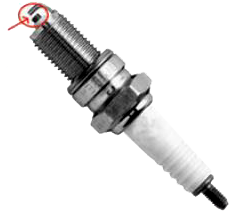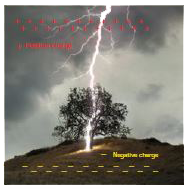Complete Solutions to Exercises of chapter ELECTROSTATICS of Class 12 book with complete answers and questions
| Class 12 | PHYSICS |
| Chapter | ELECTROSTATICS |
| TAMILNADU GOVT | Exercises |
| Number Of Questions | 23 |
| Academic Year | 2023-24 |
When two objects are rubbed with each other, approximately a charge of 50 nC can be produced in each object. Calculate the number of electrons that must be transferred to produce this charge.
View SolutionThe total number of electrons in the human body is typically in the order of `10^(28)`. Suppose, due to some reason, you and your friend lost 1% of this number of electrons. Calculate the electrostatic force between you and your friend separated at a distance of 1m. Compare this with your weight. Assume mass of each person is 60 kg and use point charge approximation.
View SolutionFive identical charges Q are placed equidistant on a semicircle as shown in the figure. Another point charge q is kept at the center of the circle of radius R. Calculate the electrostatic force experienced by the charge q.

View SolutionSuppose a charge +q on Earth’s surface and another +q charge is placed on the surface of the Moon.
Calculate the value of q required to balance the gravitational attraction between Earth and Moon
(Take `m_(E) = 5.9 xx 10^(24)" kg,m"_(M) = 7.9 xx 10^(22)" kg"`)
View SolutionSuppose a charge +q on Earth’s surface and another +q charge is placed on the surface of the Moon.
Suppose the distance between the Moon and Earth is halved, would the charge q change?
(Take `m_(E) = 5.9 xx 10^(24)" kg,m"_(M) = 7.9 xx 10^(22)" kg"`)
View SolutionDraw the free body diagram for the following charges as shown in the figure (a), (b) and (c).

View SolutionConsider an electron travelling with a speed `v_o` and entering into a uniform electric field `vec(E )` which is perpendicular to `vec(v)_(o)` as shown in the Figure. Ignoring gravity, obtain the electron’s acceleration, velocity and position as functions of time.

View SolutionA closed triangular box is kept in an electric field of magnitude `E = 2 xx 10^(3)"N C"^(-1)` as shown in figure.

Calculate the electric flux through the
vertical rectangular surface
View SolutionA closed triangular box is kept in an electric field of magnitude `E = 2 xx 10^(3)"N C"^(-1)` as shown in figure.

Calculate the electric flux through the
slanted surface and
View SolutionThe electrostatic potential is given as a function of x in figure (a) and (b). Calculate the corresponding electric fields in regions A, B, C and D. Plot the electric field as a function of x for the figure (b).

View SolutionThe electrostatic potential is given as a function of x in figure (a) and (b). Calculate the corresponding electric fields in regions A, B, C and D. Plot the electric field as a function of x for the figure (b).

View SolutionA spark plug in a bike or a car is used to ignite the air-fuel mixture in the engine. It consists of two electrodes separated by a gap of around 0.6 mm gap as shown in the figure.

To create the spark, an electric field of magnitude `3 xx 10^6" Vm"^(-1)` is required.
If the gap is increased, does the potential difference increase, decrease or remains the same?
View SolutionA point charge of `+10 muC` is placed at a distance of 20 cm from another identical point charge of `+10 muC`. A point charge of `-2 mu C` is moved from point a to b as shown in the figure. Calculate the change in potential energy of the system? Interpret your result.

View SolutionCalculate the resultant capacitances for each of the following combinations of capacitors.

View SolutionCalculate the resultant capacitances for each of the following combinations of capacitors.

View SolutionCalculate the resultant capacitances for each of the following combinations of capacitors.

View SolutionAn electron and a proton are allowed to fall through the separation between the plates of a parallel plate capacitor of voltage 5 V and separation distance h = 1 mm as shown in the figure.

Calculate the time of flight for both electron and proton
(Take `m_(p) = 1.6 xx 10^(-27)" kg, m"_(e) = 9.1 xx 10^(-31)" kg and g" = 10" ms"^(-2)` )
View SolutionAn electron and a proton are allowed to fall through the separation between the plates of a parallel plate capacitor of voltage 5 V and separation distance h = 1 mm as shown in the figure.

Suppose if a neutron is allowed to fall, what is the time of flight?
(Take `m_(p) = 1.6 xx 10^(-27)" kg, m"_(e) = 9.1 xx 10^(-31)" kg and g" = 10" ms"^(-2)` )
View SolutionAn electron and a proton are allowed to fall through the separation between the plates of a parallel plate capacitor of voltage 5 V and separation distance h = 1 mm as shown in the figure.

Among the three, which one will reach the bottom first?
(Take `m_(p) = 1.6 xx 10^(-27)" kg, m"_(e) = 9.1 xx 10^(-31)" kg and g" = 10" ms"^(-2)` )
View SolutionDuring a thunder storm, the movement of water molecules within the clouds creates friction, partially causing the bottom part of the clouds to become negatively charged. This implies that the bottom of the cloud and the ground act as a parallel plate capacitor. If the electric field between the cloud and ground exceeds the dielectric breakdown of the air `(3 xx 10^(6)" Vm"^(-1)` ), lightning will occur.

If the bottom part of the cloud is 1000 m above the ground, determine the electric potential difference that exists between the cloud and ground.
View SolutionDuring a thunder storm, the movement of water molecules within the clouds creates friction, partially causing the bottom part of the clouds to become negatively charged. This implies that the bottom of the cloud and the ground act as a parallel plate capacitor. If the electric field between the cloud and ground exceeds the dielectric breakdown of the air `(3 xx 10^(6)" Vm"^(-1)` ), lightning will occur.

In a typical lightning phenomenon, around 25C of electrons are transferred from cloud to ground. How much electrostatic potential energy is transferred to the ground?
View SolutionFor the given capacitor configuration
(a) Find the charges on each capacitor
(b) potential difference across them
(c) energy stored in each capacitor

View SolutionCapacitors P and Q have identical cross sectional areas A and separation d. The space between the capacitors is filled with a dielectric of dielectric constant `epsilon_(r)` as shown in the figure. Calculate the capacitance of capacitors P and Q.

View Solution
Exercises questions and complete solutions for chapter ELECTROSTATICS of FULL MARKS PHYSICS(TAMIL) of Class 12